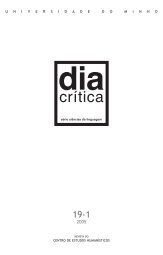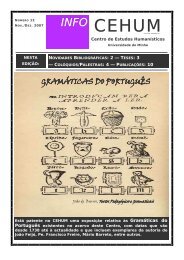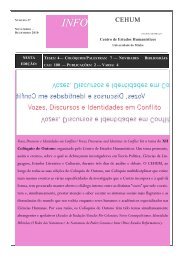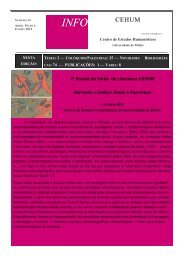Diacritica 25-2_Filosofia.indb - cehum - Universidade do Minho
Diacritica 25-2_Filosofia.indb - cehum - Universidade do Minho
Diacritica 25-2_Filosofia.indb - cehum - Universidade do Minho
You also want an ePaper? Increase the reach of your titles
YUMPU automatically turns print PDFs into web optimized ePapers that Google loves.
168<br />
GEORGINA ABREU<br />
ways. Th is discussion became political and it thus transcended the limits of<br />
middle-class ideas of <strong>do</strong>mesticity.<br />
Th e method was the rhetoric of melodrama. Th e appeal to the sentiments<br />
of the people in defence of a lonely and persecuted woman who was<br />
Queen of England, accused and friendless, accounted for the success of the<br />
radical press version of the Queen Caroline aff air. Cobbett emphasised that<br />
it was a ‘distinguishing characteristic of the people of this country, to sympathise<br />
with the oppressed and to lend assistance to the weak in their struggles<br />
with the strong’ (PR, vol. xxxvii: 422). Wooler made the same point in<br />
the BD of 14 June, when the ‘Black Dwarf ’ commented on the enthusiastic<br />
popular reception of the Queen by asking: ‘is it not better to applaud a<br />
defenceless woman than to persecute her?’ (BD, vol. iv: 800).<br />
Th e extensive and massive mobilisation of public opinion changed<br />
the face of popular radicalism itself by making it more ‘popular’, and even<br />
populist. [11] Th e populist dimension was most prominent in the production<br />
of ephemeral print forms such as handbills, songs, advertisements, and<br />
satirical prints, but it was also present in the less ephemeral periodicals of<br />
the radical press. Th e BD, for example published on 5 July, the day of the<br />
introduction of the Bill of Pains and Penalties in the House of Lords, William<br />
Benbow’s highly infl amed handbill ‘Proposal to Murder the Queen!’<br />
(BD, vol. v: 27). On 12 July, Jane Carlile published the satirical print ‘Arrival<br />
of the Wretches’, reporting the arrival at Dover, on the 7 th , of seven Italian<br />
witnesses against the Queen (BMC [12] 13758).<br />
Th is extensive mobilisation of the labouring classes and even the middle-classes<br />
showed that public opinion was competing ever more with Parliament<br />
as the voice of the people, the more so as Parliament was viewed<br />
by large sections of the population as a corrupt body that did not fulfi l its<br />
representational goal. Public opinion consisted of the people discussing<br />
matters of public interest openly and fairly. Th is was one of the ways in<br />
which the radical appropriation of the Caroline aff air contributed to the<br />
democratisation of the public sphere. It placed print culture at the vanguard<br />
of radical political struggle.<br />
Th is meant that ‘physical force’ strategies were gradually giving way to<br />
strategies where words and images were the main political tools. Cobbett<br />
vehemently refused that the reading of his PR or of any other radical writ-<br />
11 Th e populist character is especially noted in the production of ultra-radical publishers and<br />
authors, such as William Benbow and Allen Davenport.<br />
12 Abbreviation of Catalogue of Political and Personal Satires Preserved in the Department of Prints<br />
and Drawings in the British Museum, (George, M.D., 1952).<br />
<strong>Diacritica</strong> <strong>25</strong>-2_<strong>Filosofia</strong>.<strong>indb</strong> 168 05-01-2012 09:38:28











![Programa [pdf] - cehum - Universidade do Minho](https://img.yumpu.com/17305425/1/190x135/programa-pdf-cehum-universidade-do-minho.jpg?quality=85)




